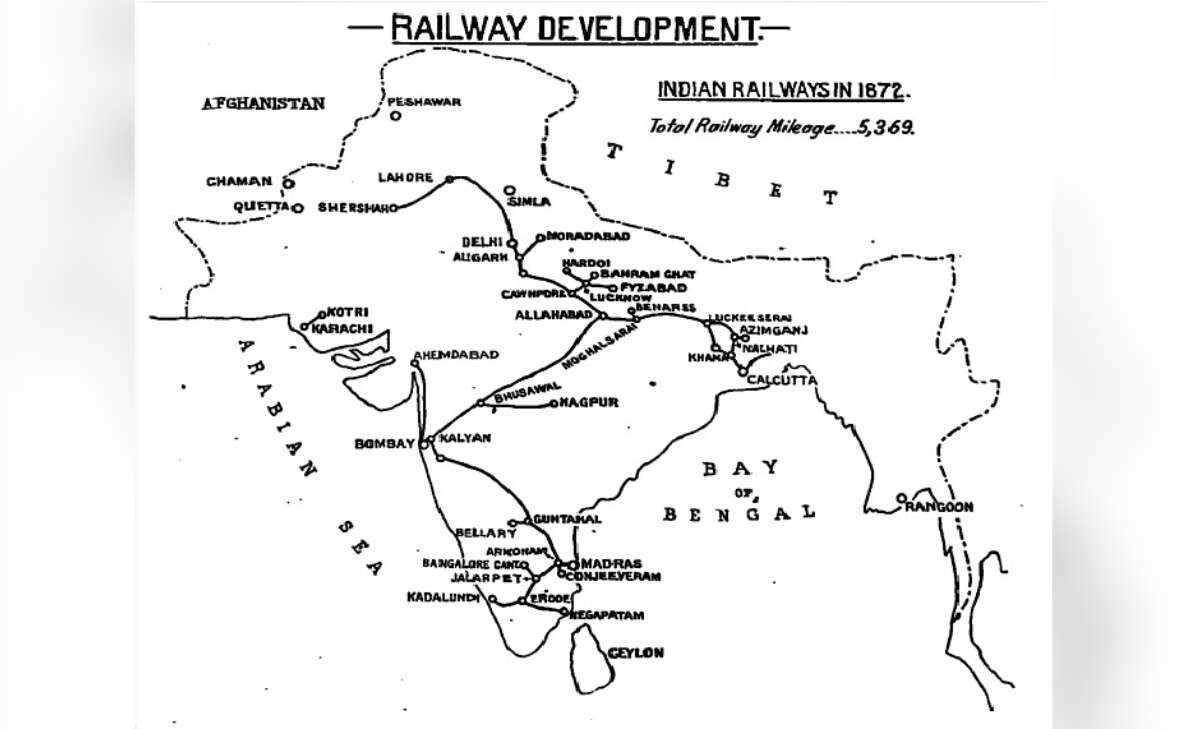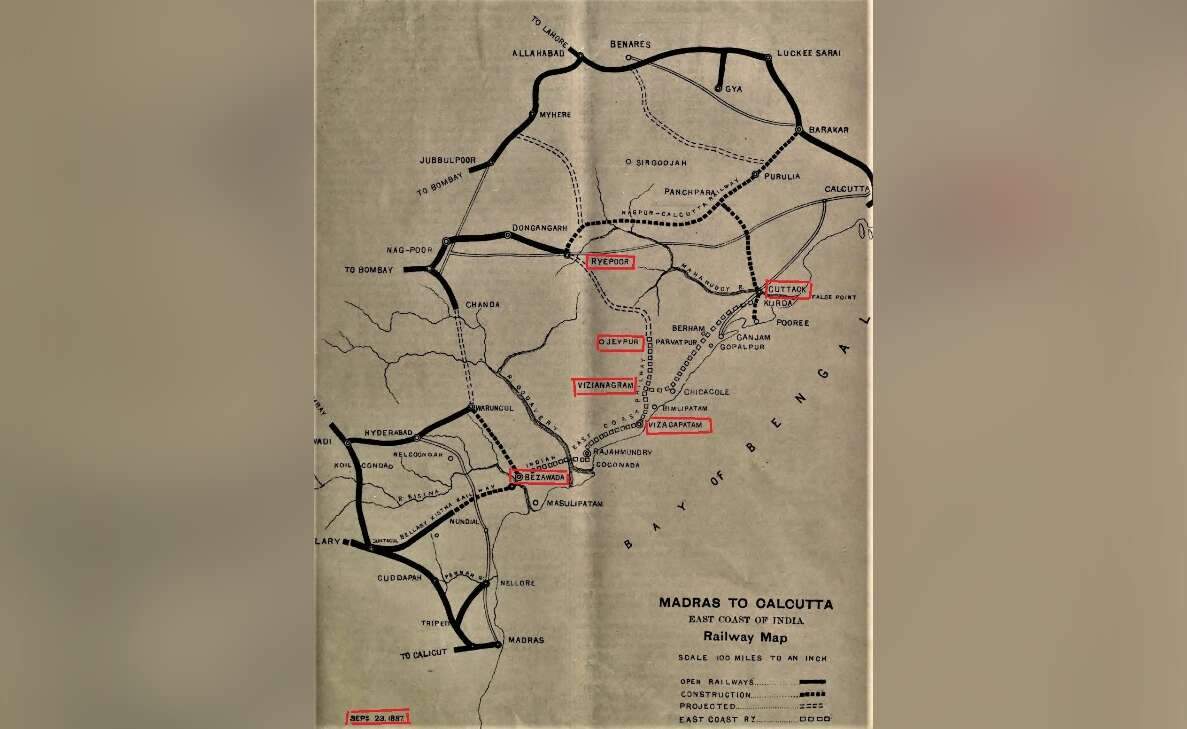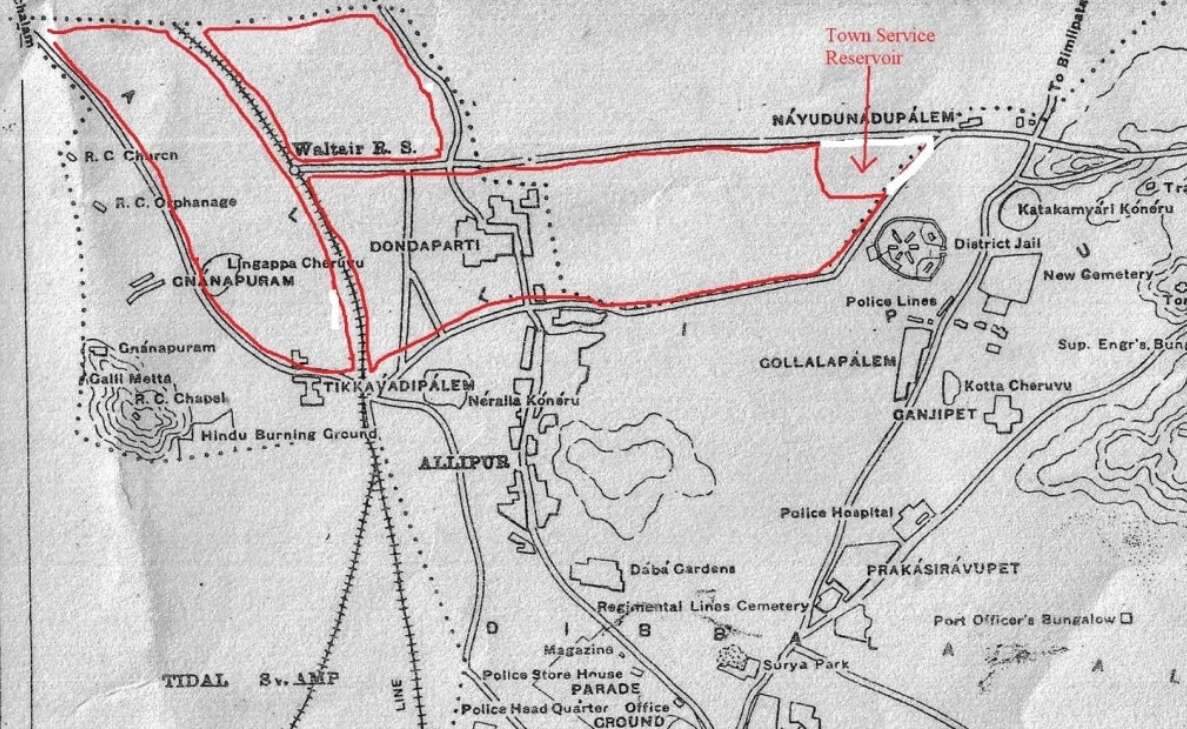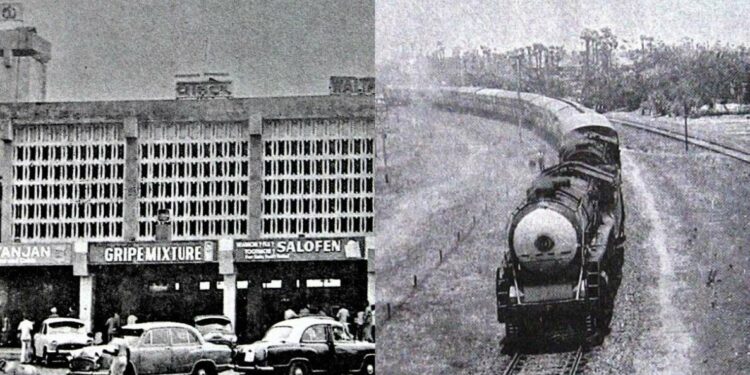With discussions rife about a new railway zone headquartered in Visakhapatnam, there is no suitable occasion than now to reminisce about the foundation of railways in the City of Destiny. What started as a remote part of an expansive network has evolved into a facility that functions like clockwork throughout the year, generating a whopping revenue.
Vijjeswarapu Edward Paul, a heritage and history enthusiast, shares an elaborate retelling of the origins of railways in Visakhapatnam.
Also read: The first wings over Vizag: An ode to the city’s rich history
Introduction
The Great Indian Peninsular Railway (GIPR) constructed and operated the first Railway Line in India between Bombay to Thane, and the first passenger train on Indian soil ran over a stretch of 21 miles (33.6 km) between these two stations on 16th April 1853.
East India Railway Company (EIR) ran its first passenger train on 15th August 1854 from Howrah to Hugly, a distance of 24 miles (38.4 km).
In the south, the first Line was opened on 1st July 1856 by the Madras Railway (MR) Company from Vyasarpadi Jeeva (Veyasarpandy) and Walajah Road (Arcot), a distance of 63 miles (100.8 km)
The Governance of India was assumed by the Crown of England from 1858, and the Secretary of State for India was governing from England through the Governor General of India. The Government already had plans to connect all the presidency towns through Railway Lines in a phased manner, with the available capital. The famine in parts of India during the 1870s hastened the Government to go for Lines that would serve the movement of grains to reach famine-affected regions in time so as to save hundreds of lives.
 As can be seen from the Railway map of 1872 given in Fig 1 above, most of the east coast of India was not covered by the railway network.
As can be seen from the Railway map of 1872 given in Fig 1 above, most of the east coast of India was not covered by the railway network.
History of Railways in Visakhapatnam
Many representations were given to the Government advocating, connecting Visakhapatnam with a railway line. Three prominent persons in authority besides the local residents of the city pleaded for a railway connection.
1. E.C.G. Thomas, District Judge in Visakhapatnam
2. The Maharajah of Vizianagaram
3. H.G. Turner, the District Collector of Visakhapatnam
4. Native residents of Visakhapatnam, consisting of all sections of people
E.C.G. Thomas sent a memorandum to the Government, recommending the construction of an inland with Central Province’s harbour at Visakhapatnam and connecting the harbour by a railway line. The memorandum titled “Vizagapatam: The port for the Central Provinces” was submitted in 1877.
The Maharajah of Vizianagaram made representations for the construction of a railway line from Bimilipatam or from Visakhapatnam (Vizagapatam was known then) to Raipur in Central Provinces via Vizianagaram. In 1880, he requested the Madras government to do a survey of the Line and offered to bear the cost of the survey to the extent of Rs. One lakh. The Famine Commission recommended his proposal to the Secretary of State in England.
Both ECG Thomas and Maharajah of Vizianagaram have recommended a railway line to Raipur, and Thomas recommended an Inner Harbour also at Vizagapatam.
According to the request of the Maharajah’s representation in 1880, a reconnaissance was made in 1881-82. The detailed survey was carried out in 1897-98, and the British Government sanctioned the project in 1905. But the line could be completed only up to Parvatipur by 1909. Further work was abandoned for want of funds.
Later, the construction of the Raipur-Parvatipur section and the development of Vizagapatam as a major port was sanctioned by the Secretary of State in March 1925. Raipur – Vizianagaram Line was opened for traffic in 1931, and Visakhapatnam Port was opened for traffic in 1933.
The recommendations made by Thomas, and Maharajah took nearly 50 years to fructify.
Role of H.G. Turner
H.G.Turner, who was the Collector of Visakhapatnam from 1881 to 1889, submitted a separate memorandum to the Government in 1887 to lay a Railway Line from Vijayawada (Bezwada as was known then), through Visakhapatnam, to Cuttack in Bengal Province with the ultimate plan of connecting Madras with Calcutta. His proposal also included a Line from Vizianagaram to Jeypore in Orissa, with a provision to extend it up to Raipur in future. A sketch of Railway Lines that were already in existence and the proposed Line named by him “East Coast Railway Line” was attached to his memorandum with all the required details. The sketch from that memorandum is given below as Fig- 2.
The people of Visakhapatnam made a representation to the Government to connect Visakhapatnam with Madras and Calcutta with a railway line. This news was published on 7th July 1888. The news item states that “ A crowded meeting, representative of all classes of the community has been held at Vizagpatam for the purpose of memorializing the Government on the question of constructing a coast railway connecting Madras with Calcutta”.
 The Government accepted the Collector H.G. Turner’s proposal and decided to carry out a survey of the Line from Vijayawada to Cuttack in 1888.
The Government accepted the Collector H.G. Turner’s proposal and decided to carry out a survey of the Line from Vijayawada to Cuttack in 1888.
A new railway company was formed under the title “East Coast State Railway”, which was fully owned by the Government. The task assigned to the company was to lay a railway line from Tadepalli, near Vijayawada (Bezwada as was known then) on the south bank of river Krishna to Barang on the right bank of the river Mahanadi near Cuttack. The total length was about 504 miles, and the cost was estimated to be around Rs.480 lakhs. This included the construction of major bridges, over rivers such as Krishna near Vijayawada, Godavari near Rajahmundry, Langulya, Vamsadhara, and Rushikulya. The construction of the work was sanctioned in July 1890.
To connect the link between Madras and Calcutta (Howrah), some more stretches of Railway Lines were to be laid at both ends, as Madras was not connected to Tadepalli by a broad gauge line and similarly, Calcutta (Howrah) was not connected to Barang. So the Govt of India had given the contract to Bengal Nagpur Railway Company to lay a railway line from Barang to Howrah via Balasore and Kharagpur. The B.N.Railway functioned from its headquarters at Nagpur until 1899, and from then, it was shifted to Garden Reach in Calcutta. The job of connecting Madras with Tadepalli via Gudur and Nellore with a broad-gauge line was entrusted to the Madras Railway.
For the purpose of construction, the Line was divided into 8 sections, and the work was undertaken simultaneously in all sections. Each section opened for traffic as and when they were completed.
The first section to be completed was from Vijayawada to Kovvur (on the southern bank of River Godavari), which came into operation on 20th February 1893.
The first train that passed through Waltair station was on 15th July 1893, with the opening of the traffic on the section from Rajahmundry to Vizianagaram.
A branch line from Waltair to Vizagapatam (Visakhapatnam) and also the Lines on the swamp leading up to Visakhapatnam Harbour (old harbour near the entrance channel at the foot of the Ross Hill), which was called Wharf station, was opened for traffic on 1st October 1894.
The bridge on the major river Godavari was completed and opened for traffic on 6th August 1900. The formal opening of the bridge was done by the Governor of
Madras Sir Arthur Elibank Havelock on 30th August 1900, and the bridge was named, in the name of the Governor, “Havlock Bridge”. With the opening of this, the full section of the line from Tadepalli (Krishna Canal) to Cuttack came into operation.
Finally, the line from Madras to Howrah has come into operation on 14th December 1900.
As stated earlier, the East Coast Railway Line from Tadepalli to Barang (Cuttack) was divided into 8 sections for purpose of construction, three of which were Ellore, Tuni and Waltair, and each section started its operations when that section was complete. The various Traffic Districts, during the period of operations of these sections, were amalgamated in 1900 to form two Traffic Districts, namely Madras and Waltair. This indicates that Waltair was a District right from the construction time.
As the East Coast Line was nearing completion, the stretch from Tadepalli to Washermenpet, near Madras, which was constructed by Madras Railway, was handed over to East Coast Railway in 1899.
In December 1899, the Railways decided to divide the Line from Washermenpet to Cuttack, which was in the control of East Coast Railway by then, into two sections, for purpose of ease of management and control. It selected Waltair as the point of its division.
Accordingly, from 1st January 1901, the northern section of the East Coast Line from the north-distant signal of Waltair station to Barang (Cuttack) was handed over to Bengal Nagpur Railway. The southern section of the East Coast Railway from Waltair to Washermenpet was handed over to Madras Railway for working and maintenance. This southern section included the branch line from Waltair to Visakhapatnam and Wharf stations also.
In 1908, the Madras Rly was merged with Southern Mahratta Rly to form Madras & Southern Mahratta Rly.
By 1920-21, it has been decided that the Construction of the Visakhapatnam Inner Harbour as a Major Port would be taken up by the Bengal Nagpur Rly. Then it became imperative to transfer the Harbour Wharf station along with a section of Waltair and its branch line to Visakhapatnam, from MSM Rly to Bengal Nagpur Rly in 1925. With this, MSM Rly’s Waltair Railway District was shifted to
Vijayawada became a Railway District for the first time. B.N. Rly subsequently made Waltair their Railway District later.
The new Visakhapatnam Inland Harbour constructed by Bengal Nagpur Railway was opened for ocean-going vessels on 7th October 1933, and a formal opening by the Viceroy of India took place on 19th December 1933.
The Waltair and its branch Lines to Visakhapatnam Town and harbour Wharf were under different Zonal Railways, as shown under
| 1890 – | 1902 : | East Coast State Railway |
| 1802 – | 1908 : | Madras Railway |
| 1908 – | 1925 : | Madras & Southern Mahratta Railway |
| 1925 – | 1952 : | Bengal Nagpur Railway |
| 1952 – | 1955 : | Eastern Railway |
| 1955 – | 2003 : | South Eastern Railway |
| 2003 – | ???? : | East Coast Railway |
A new zone was created in 2003 with the same old name as “East Coast Rly”, creating confusion between the old and new Railways. To avoid that confusion, the old one can be referred to as East Coast State Rly and the new one as East Coast Zonal Rly.
Waltair was a Railway District from 1890 up to 1966. After the South Central Railway was formed with its headquarters at Secunderabad on 2nd Oct 1966, the Railway District of Waltair was made into a Railway Division as the Railway Board has taken a decision to have a divisional system of working in all Zonal Rlys. By the end of Dec 1966, Waltair Railway District was made into a Railway Division.
Railway Heritage in Visakhapatnam
The East Coast Railway constructed three Railway stations in Visakhapatnam city, namely Waltair, Vizagapatam (Visakhapatnam Town) and Harbour Wharf.
Waltair was a suburb of Visakhapatnam. High Army and civilian officers in Visakhapatnam started moving to Waltair in 1727 as that highland was cooler than the Visakhapatnam town. They built their residential bungalows there. A point of the Rly Line that was nearest to the Waltair suburb was chosen for constructing a station to be named Waltair Station. Actually, Waltair was about 4 to 5 km away from that station.
Regarding the name “Waltair”, people mistake it to be the name of some British High official in whose honour it was named. In fact, it is a local Telugu name, “Valuteru”, a combination of two words, Valu and eru, which means sloping stream or river. Valuteru was the name of a stream. The area where this stream was passing through was known as Valteru. The British mispronounced it as Waltair and spelt it as Waltair. But at the railway station, the name was written as Valteru in Telugu.
With the construction of the Inner Harbour, the Wharf station was shifted to Inner Harbour. Visakhapatnam Port Trust took over the Railway Lines in the Port from South Eastern in 1964 after it became a Port Trust. Visakhapatnam Port Station is open only for goods traffic and is still working under Port Trust.
The Vizagapatam station was renamed Visakhapatnam Town sometime after Independence. After some years, the station was utilised only for Goods, and no passenger train was going to that station. Subsequently, around 1980 the station was closed and abandoned.
The Waltair Railway station was renamed Visakhapatnam around 1987.
Development of the city around the Waltair Railway Station
When the East Coast Railway has taken up the job of construction, they started acquiring vast land in the city for the track on the open lines and for stations, sheds, yards, workshops, bungalows for officers and Quarters for staff according to their rank and status. The process of land acquisition for Railways resulted in the relocation of two villages in the city.
At that time, the town of Visakhapatnam was not much developed. A vast stretch of land was vacant with sparsely located villages. The railways acquired land that was in front of the Waltair Station right up to the present road leading from RTC Complex Junction to Ambedkar statue on Jail road, perhaps with the exception of the Visakhapatnam Town Service Reservoir site. The area is roughly marked in the map given below in Fig-3. The village of Dondaparthi was lying in this area. For handing over this area to Railways, the Dondaparthi Village was relocated to its present location. It was a well-laid-out plan with service lanes. Most of the Officers’ bungalows and offices were constructed on the east side of Waltair station.

The Railways acquired land on the west side of Waltair station i.e Jnanapuram side also. Tikkavanipalem village was located towards that side, and that village was also relocated. But no new area was developed with the name Tikkavanipalem, as was done in the case of Dondaparthi. Simply the villagers of Tikkavanipalem were relocated to Kancharapalem and Rammurthy Panthulupeta as their extensions. On Jnanapuram’s side, about 200 acres of land were also purchased from the Roman Catholic Bishop for Rlys. Initially, most of the quarters for staff were constructed on the Jnanapuram side, which was known as MSM Colony.
From 1925 onwards, there were two establishments of B N Rly working in Visakhapatnam; one establishment was Waltair Railway District, with various Rly District officers. The other establishment was connected with the construction of Visakhapatnam harbour, headed by an Engineer in Chief. Both these two establishments seem to have shared the land and resources. So it is now difficult to establish which establishment constructed the East Point Rest House. The Port quarters for Harbour staff were constructed in the old Dondaparthi area, which was purchased by East Coast Rly District.
Before the Railways came, Visakhapatnam was only limited to the old city, Waltair being a suburb with senior Army and Civilian Officers. Visakhapatnam expanded towards the north after the Railways came. The city spread further after the establishment of the harbour constructed by B.N.Rly.
The number of Railway Bungalows for officers and Quarters for staff much increased with the establishment of DBK Railway Head Quarters in 1960, which was considered to be a Zonal Rly, as a large number of officials started arriving from different Zones on deputations.
Role of railways in Social and Cultural changes in Visakhapatnam
There was a large influx of many Anglo Indians for employment in Railways in both the Harbour establishment and the Rly District. In addition, native people from other states also came in large numbers.
The East Coast Rly officers in its early days of construction and afterwards seem to have joined the Waltair Club for their recreation and social life. They arrived in Visakhapatnam only after 1890 and became members from then onwards.
The Anglo-Indian staff had the Railway Institute for their cultural and social activities. The Institute had wooden flooring. They used to have dances for New Year and other special days. The Institute was also used as a shuttle badminton court.
The natives from other states, mostly from Bengal, also arrived in Visakhapatnam with the Railways. The Head Quarters of B N Rly were at Calcutta, and perhaps more Bengalis came to Visakhapatnam. It is believed that the culture of Durga Puja was brought by them to Visakhapatnam and that the Puja Pandal, raised every year near the railway station, is considered to be the oldest in the city. Today we have hundreds of Durga Puja Pandals.
Epilogue
Before concluding this article, a word or two about E.C.G Thomas and H.G. Turner deserve to be mentioned.
E.C.G. Thomas worked as a Judge in Visakhapatnam. He constructed a residence for himself in 1871 on Kailasa hill, which is about 1,600 feet above sea level. He used to get down the hill and take a horse-drawn carried to go to his court in the old town. According to his reports, he was happy and comfortable residing there. But people thought that he was foolish to reside there and called that place Thomas Folly. Now nothing remains of that building at that place with the tourist developments that have taken place. In some old maps, that place was marked as Thomas Folly.
Henry Gribble Turner worked as a District Collector from June 1881 to April 1883 and went on furlough to England for one year, came back and worked as Collector of Visakhapatnam from April 1884 to April 1889. Most of his previous service too was in Visakhapatnam District. He was a very popular Collector at that time. After his death, a Choultry as a memorial was constructed by raising contributions from the public and the site was donated by Maharajah G.N. Gajapati Rao and was named Turner’s Chuttram in his honour. It was handed over to the Municipality for administration in 1898. Presently it is under Endowments Department. It is still serving the public.
A few old Railway building photos are reproduced here

Compiled: Vijjeswarapu Edward Paul
Email: edwardpaulv@gmail.com
Mobile: +91 94401 73695
Stay tuned to Yo! Vizag website and Instagram for more heritage stories.



















Discussion about this post